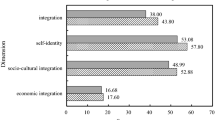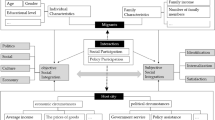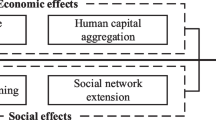Abstract
Migrants’ socio-economic integration is a major theme in migration research, which can provide economic and cultural benefits. And it will contribute to social stability. The investigation from the spatial perspective should also be considered. This paper aims to examine the spatial differentiation of the socio-economic integration of migrants and identify its driving forces to provide crucial evidence and policy recommendations to urban policymakers and further improve migrants’ socio-economic integration. Based on the latest China Migrants Dynamic Survey, this paper uses global Moran’s I index, hot spot analysis and GWR model to explore spatial differentiation and driving forces of the socio-economic integration of 155,789 migrants in 291 cities at prefecture level and above in China. The results show that: (1) The socio-economic integration of migrants consists of five dimensions, which are economic integration, cultural integration, social security, social relation and psychological integration. Among them, psychological integration is the highest (73.16) and economic integration is the lowest (13.38). (2) The socio-economic integration of migrants is mainly influenced by their own characteristics instead of the destination characteristics. Four factors (age, education, length of stay and population growth rate) positively affect migrants’ socio-economic integration, while three factors (inter-provincial mobility, proportion of tertiary industry in GDP, and ratio of teacher to student in middle school) negatively impact the socio-economic integration of migrants. (3) The socio-economic integration of migrants shows the distribution pattern of agglomeration. And the integration also presents a significant spatial heterogeneity. The driving forces of the socio-economic integration exhibit various zonal spatial differentiation patterns, including “E–W”, “SE–NW”, “NE–SW”, and “S–N”. Finally, some useful recommendations are given for improving migrants’ socio-economic integration.





Similar content being viewed by others
Data Availability
Research data are not shared.
References
Alemu, B. B., Vehams, H., & Nagel, S. (2021). Social integration of Ethiopian and Eritrean women in Switzerland through informal sport settings. European Journal for Sport and Society, 2, 1–20.
Bolt, G. A., Özüekren, S., & Phillips, D. (2012). Linking integration and residential segregation. Routledge.
Chen, Y. (2011). Occupational attainment of migrants and local workers: Findings from a survey in Shang hai’s manufacturing sector. Urban Studies, 48(1), 3–21.
Chen, Y., & Wang, J. (2015). Social integration of new-generation migrants in Shanghai China. Habitat International, 49, 419–425.
Cui, N., Feng, C., & Song, Y. (2017). Spatial pattern of residential land parcels and determinants of residential land price in Beijing since 2004. Acta Geographica Sinica, 72(6), 1049–1062.
Démurger, S., Gurgand, M., Li, S., & Yue, X. (2009). Migrants as second-class workers in urban China? A decomposition analysis. Journal of Comparative Economics, 37(4), 610–628.
Forrest, R., & Kearns, A. (2001). Social cohesion, social capital and the neighbourhood. Urban Studies, 38(12), 2125–2143.
Fotheringham, A. S., Brunsdon, C., & Charlton, M. (2003). Geographically weighted regression: The analysis of spatially varying relationships. Wiley.
Fotheringham, A. S., Kelly, M. H., & Charlton, M. (2013). The demographic impacts of the Irish famine: Towards a greater geographical understanding. Transactions of the Institute of British Geographers, 38(2), 221–237.
Glazer, N. (1998). Pluralism and the new immigrants. Society, 35(2), 232–238.
Goldlust, J., & Richmond, A. H. (2006). A multivariate model of immigrant adaptation. International Migration Review, 8(2), 193.
Gordon, D., et al. (Eds.). (2000). Poverty and social exclusion in Britain. Joseph Rowntree Foundation.
Gordon, M. M. (1964). Assimilation in American life. Oxford University Press.
Griffith, D. A. (2003). Spatial autocorrelation and spatial filtering: Gaining understanding through theory and scientific visualization. Journal of Regionalence, 44(3), 633–635.
Gu, H. Y., Liu, Z. L., & Shen, T. Y. (2020a). Spatial pattern and determinants of migrant workers’ interprovincial hukou transfer intention in China: Evidence from a national migrant population dynamic monitoring survey in 2016. Population, Space and Place, 26(2), 1–16.
Gu, H. Y., Meng, X., Shen, T. Y., & Cui, N. N. (2020b). Spatial variation of the determinants of China’s urban floating population’s settlement intention. Acta Geographica Sinica, 75(2), 240–254.
Gutierrez-Posada, D., Rubiera-Morollon, F., & Vinuela, A. (2015). Heterogeneity in the determinants of population growth at the local level analysis of the Spanish case with a GWR approach. International Regional Science Review, 40(3), 211–240.
Hainmueller, J., Hangartner, D., & Pietrantuono, G. (2017). Catalyst or crown: Does naturalization promote the long-term social integration of immigrants. American Political Science Review, 111(2), 256–276.
He, X. (2010). Applied multivariate statistical analysis. China Statistics Press. in Chinese.
Kearns, A., & Whitley, E. (2015). Getting there? The effects of functional factors, time and place on the social integration of migrants. Journal of Ethnic and Migration Studies, 41(13), 2105–2129.
Laurence, J. (2011). The effect of ethnic diversity and community disadvantage on social cohesion. European Sociological Review, 27(1), 70–89.
Letki, N. (2008). Does diversity erode social cohesion? Social capital and race in British neighbourhoods. Political Studies, 56(1), 99–126.
Lin, L. Y., & Zhu, Y. (2016). Spatial variation and its determinants of migrants’ hukou transfer intention of China’s prefecture- and provincial-level cities: Evidence from the 2012 national migrant population dynamic monitoring survey. Acta Geographica Sinica, 71(10), 1696–1709.
Lin, Y., Zhang, Q., Chen, W., & Ling, L. (2017). The social income inequality, social integration and health status of internal migrants in China. International Journal for Equity in Health, 16(1), 139.
Liu, L., Huang, Y., & Zhang, W. (2017). Residential segregation and perceptions of social integration in Shanghai China. Urban Studies, 55(7), 1484–1503.
McCaa, R. (1989). Isolation or assimilation? A log linear interpretation of Australian marriages, 1947–60, 1975, and 1986. Population Studies, 43(1), 155–162.
Musgrave, S. (2014). Language and social inclusion: Unexplored aspects of intercultural communication. Australian Review of Applied Linguistics, 37(3), 198–212.
Naveed, A., & Wang, C. (2021). Can attitudes toward immigrant explain social integration in Europe? EU versus non-EU migrant. Social Indicators Research, 153(6), 1–39.
Niu, G., & Zhao, G. (2018). Identity and trust in government: A comparison of locals and migrants in urban China. Cities, 83, 54–60.
Park, R. E. (1928). Human migration and the marginal man. American Journal of Sociology, 33(6), 881–893.
Piller, I. (2014). Linguistic diversity and social inclusion in Australia. Australian Review of Applied Linguistics, 37(3), 189–197.
Portes, A., & Zhou, M. (1993). The new second generation: Segmented assimilation and its variants among post-1965 immigrant youth. Annals of the American Academy of Political and Social Science, 530, 74–96.
Qin, Y., Ren, G., Huang, Y., Zhang, P., & Wen, K. (2021). Application of geographically weighted regression model in the estimation of surface air temperature lapse rate. Journal of Geographical Sciences, 31(3), 389–402.
Remennick, L. (2004). Language acquisition, ethnicity and social integration among former Soviet immigrants of the 1990s in Israel. Ethnic and Racial Studies, 27(3), 431–454.
Robinson, D. (2010). The neighbourhood effects of new immigration. Environment and Planning A, 42(10), 2451–2466.
Schneeweis, N. (2011). Educational institutions and the integration of migrants. Journal of Population Economics, 24(4), 1281–1308.
Schwarzweller, H. K. (2006). Parental family ties and social integration of rural to urban migrants. Journal of Marriage and the Family, 26(4), 410.
Shubin, S., & Dickey, H. (2013). Integration and mobility of Eastern European migrants in Scotland. Environment and Planning A, 45(12), 2959–2979.
Tobler, W. R. (1970). A computer movie simulating urban growth in the detroit region. Economic Geography, 46, 234–240.
Wang, M., & Ning, Y. (2015). Social Integration of Migrants in Shanghai’s Urban Villages. Acta Geographica Sinica, 16(8), 1243–1255.
Wang, W. W., & Fan, C. C. (2012). Migrant workers’ integration in urban China: Experiences in employment, social adaptation, and self-identity. Eurasian Geography and Economics, 53(6), 731–749.
Wang, Z., Zhang, F., & Wu, F. (2015). Intergroup neighbouring in urban China: Implications for the social integration of migrants. Urban Studies, 53(4), 651–668.
Wei, L., & Gao, F. (2017). Social media, social integration and subjective well-being among new urban migrants in China. Telematics and Informatics, 34, 786–796.
Wuthnow, R., & Hackett, C. (2003). The social integration of practitioners of non-western religions in the United States. Journal for the Scientific Study of Religion, 42(4), 651–667.
Yang, J. H. (2015). Research on social integration of Chinese floating population. Social Sciences in China, 2, 61–79.
Yue, Z. S., Li, S. Z., Jin, X., & Feldman, M. W. (2013). The role of social networks in the integration of Chinese rural-urban migrants: A migrant-resident tie perspective. Urban Studies, 50(9), 1704–1723.
Zheng, S. Q., Liao, J. P., Ren, R. R., & Cao, Y. (2011). Housing policy and economic growth of migrant workers. Economic Research Journal, 2, 73–86.
Zheng, S. Q., Song, Z. D., & Sun, W. Z. (2020). Do affordable housing programs facilitate migrants’ social integration in Chinese cities. Cities. https://doi.org/10.1016/j.cities.2019.102449
Zhou, H. (2012). Measurement and theoretical thinking of social integration of migrants. Population Research, 36(3), 27–37.
Zhu. (2002). On the urban adaptability of the peasant-worker strata. Jianghai Academic Journal, 6, 82–88.
Zou, J., Chen, Y., & Chen, J. (2020). The complex relationship between neighbourhood types and migrants’ socio-economic integration: the case of urban China. Journal of Housing and the Built Environment, 35(1), 65–92.
Zou, J., & Deng, X. J. (2020). Residential neighbourhood choices, capital investment and economic integration of migrants in Chinese cities. Cities. https://doi.org/10.1016/j.cities.2020.102752
Zou, J., & Deng, X. J. (2021). The effect and mechanism of neighbourhood choice on socioeconomic integration of migrants: Evidence from China. Journal of Community Psychology, 49, 620–652.
Funding
The research was funded by Natural Science Foundation of Zhejiang Province (LQ21G030015), China Postdoctoral Science Foundation (2021M692844), Zhejiang women's Federation and Zhejiang women's Research association Project (202144) and Postdoctoral research base of Zhejiang University & Hangzhou International Urbanology Research Center.
Author information
Authors and Affiliations
Corresponding author
Ethics declarations
Conflict of interest
The authors declare that they have no conflict of interest.
Additional information
Publisher's Note
Springer Nature remains neutral with regard to jurisdictional claims in published maps and institutional affiliations.
Rights and permissions
About this article
Cite this article
Zou, J., Deng, X. Spatial Differentiation and Driving Forces of Migrants’ Socio-Economic Integration in Urban China: Evidence from CMDS. Soc Indic Res 159, 1035–1056 (2022). https://doi.org/10.1007/s11205-021-02785-6
Accepted:
Published:
Issue Date:
DOI: https://doi.org/10.1007/s11205-021-02785-6




